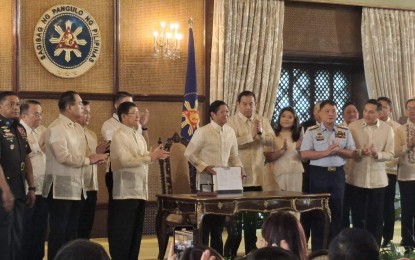Marcos signs laws charting PH maritime zones, sea lanes

NEW LAWS President Ferdinand R. Marcos Jr. signs into law the Philippine Maritime Zones Bill and the Philippine Archipelagic Sea Lanes Bill in a ceremony in Malacañang in Manila on Friday (Nov. 8, 2024). The new laws will be known as the Republic Act (RA) 12064 or the Philippine Maritime Zones Act and RA 12065 or the Philippine Archipelagic Sea Lanes. (Photo from Malacañang Press Corps Pool)
MANILA, Philippines — President Ferdinand “Bongbong” Marcos Jr. on Friday signed the Philippine Maritime Zones Act and the Philippine Archipelagic Sea Lanes Act.
To be known as Republic Act (RA) No. 12064, the Philippine Maritime Zones Act aims to declare the country’s maritime zones in accordance with the standards set by the United Nations Convention on the Law of the Sea (UNCLOS).
READ: PH Maritime Zones Act OKd, now up for Marcos signature – Tolentino
It will also clarify the geographical extent of the Philippine maritime domain and specify the legal powers that the Philippines may exercise over these areas.
Article continues after this advertisementMeanwhile, RA 12065, or the Philippine Archipelagic Sea Lanes Act, complements the Philippine Maritime Zones Act in ensuring the protection of the country’s sovereignty and maritime domain.
Article continues after this advertisementIt will design routes and areas that shall be utilized and accessed by foreign military vessels and foreign-registered aircraft for passage.
This move follows the UNCLOS and the Convention on International Civil Aviation, or the “Chicago Convention.”
Marcos signed the two new laws in a ceremony in Malacañang, Manila.
In his keynote speech, the President said the signing of RAs 12064 and 12065 demonstrates the country’s commitment as a responsible member of the international community and advocacy to uphold rules-based international order.
He noted that the laws signal his administration’s resolve to protect the country’s maritime resources, preserve its rich biodiversity, and ensure that Philippine waters remain a source of life and livelihood for all Filipinos.
“Today, we gather for the signing of two very significant laws that emphasize the importance of our maritime and archipelagic identity – the Philippine Maritime Zones Act and the Philippine Archipelagic Sea Lanes Act,” he said.
“With these pieces of legislation, we align our domestic laws with international law, specifically the UN Conventions on the Law of the Sea or UNCLOS, to improve our capacity for governance and reinforce our maritime policies for economic development and for national security.”
Marcos said the new laws signify the government’s commitment to ensure the safety and prosperity of the Philippine maritime domain.
He pointed out that the declaration of the country’s maritime zones and archipelagic sea lanes demonstrates his administration’s assertion of the country’s rights as an archipelagic state while fulfilling its obligations under international law.
“It is expected that the clarity of the extent of the maritime zones and the determination of the archipelagic sea lanes will impact domestic laws and regulations at the national and at the local level,” Marcos said.
“I, therefore, call on all concerned government agencies and the local governments to review rules and regulations against these new laws with a view of undertaking the necessary steps for their effective implementation,” he added.
Maritime zones
The Philippine Maritime Zones Act or RA 12064 aims to declare the rights and entitlements of the Philippines over its maritime zones to establish legal bases for the conduct of social, economic, commercial, and other activities in the areas.
RA 12064 provides for a general declaration of the maritime zones under the jurisdiction of the Philippines, which include internal waters, archipelagic waters, territorial sea, contiguous zone, exclusive economic zone (EEZ) and continental shelf.
The new law defines the maximum extent of the territorial sea (12 nautical miles), contiguous zone (24 nautical miles), EEZ (200 nautical miles), and continental shelf.
It also allows the delineation of continental shelves extending beyond 200 nautical miles, following Article 76 of the UNCLOS.
The law also provides for sovereign rights over the Philippines’ maritime zones, establishing the country’s exclusive rights to explore and exploit living and non-living resources found in the zones, in compliance with the UNCLOS and other existing laws and treaties.
The rights of the Philippines relative to its maritime zones and entitlements shall be exercised in accordance with the UNCLOS and the awards rendered by the Hague-based arbitral tribunal in Permanent Court of Arbitration Case 23 No. 2013-19.
This case pertains to the South China Sea Arbitration between the Philippines and China handed down on July 12, 2016.
“The Philippines reaffirms its sovereignty, sovereign rights, and jurisdiction in our waters,” Marcos said.
“By defining and asserting our maritime zones, we project to the international community that we are staunchly committed to nurturing, cultivating, and protecting our maritime domain,” the chief executive explained.
Archipelagic sea lanes
Meanwhile, the Archipelagic Sea Lanes Act or RA 12065 designates the sea lanes and air routes suitable for the continuous and expeditious passage of foreign ships and aircraft through or over its archipelagic water and the adjacent territorial sea.
RA 12065 was signed to prevent arbitrary international passage in the Philippine archipelago.
It also prescribes the rights and obligations of foreign ships and aircraft exercising the right of archipelagic sea lanes passage through the established Philippine archipelagic sea lanes.
The new law penalizes non-compliance with the provisions of the law, as well as with existing fisheries, environmental, customs, fiscal, immigration, sanitary, and other pertinent laws.
Marcos said RA 12065 complements both the maritime and aerial policies by establishing a route system in the country’s archipelagic waters, as well as the airspace above it.
He said the designated archipelagic sea lanes and air routes aim to facilitate safe passage for foreign ships and aircraft without compromising national security or diminishing security for good environmental stewardship.
“These sea lanes will offer continuous, expeditious, and unobstructed transit for vessels and air transport while obliging them to comply with navigational regulations and procedures, as well as with the air rules of flight safety and protocols,” Marcos stressed.